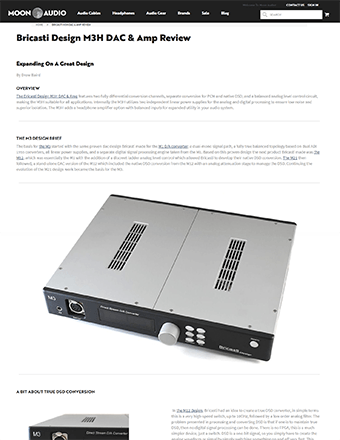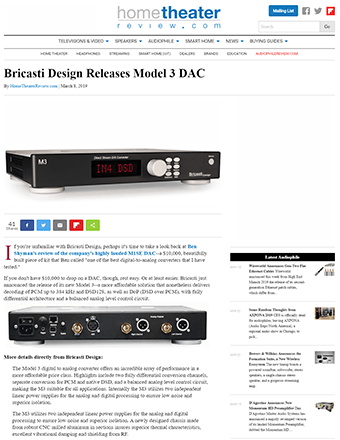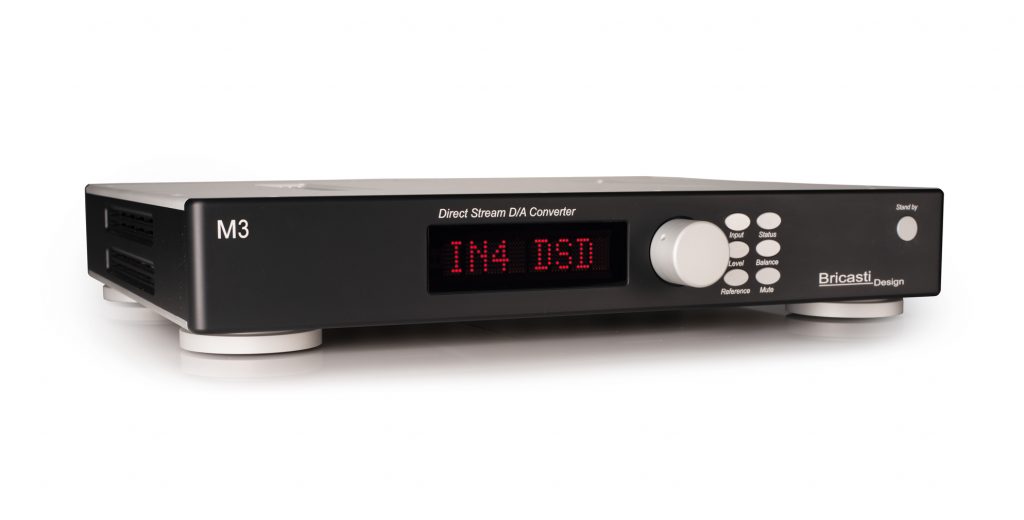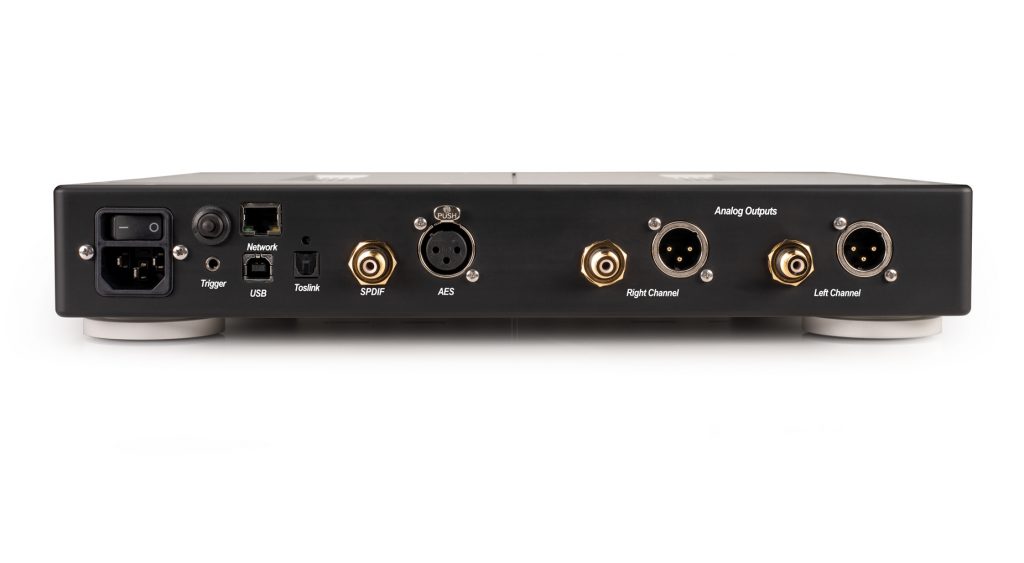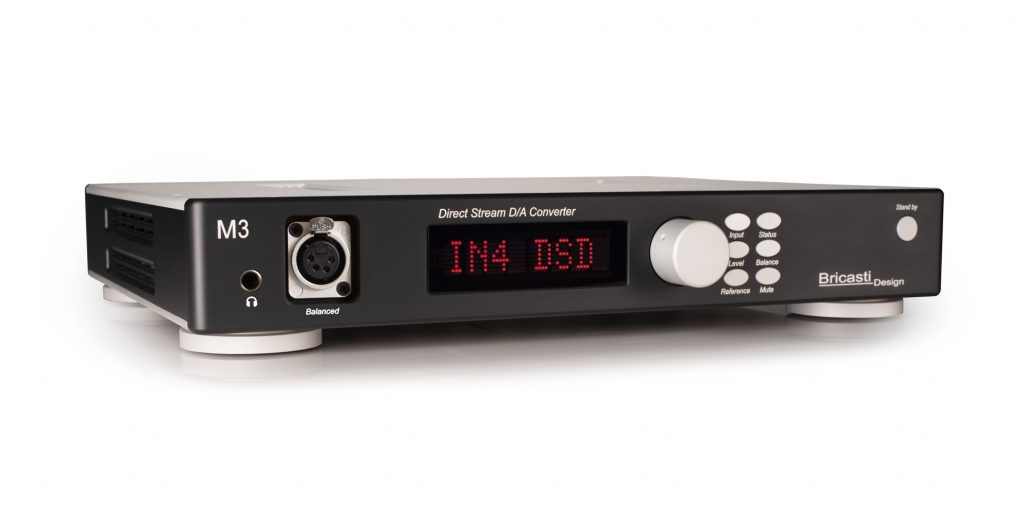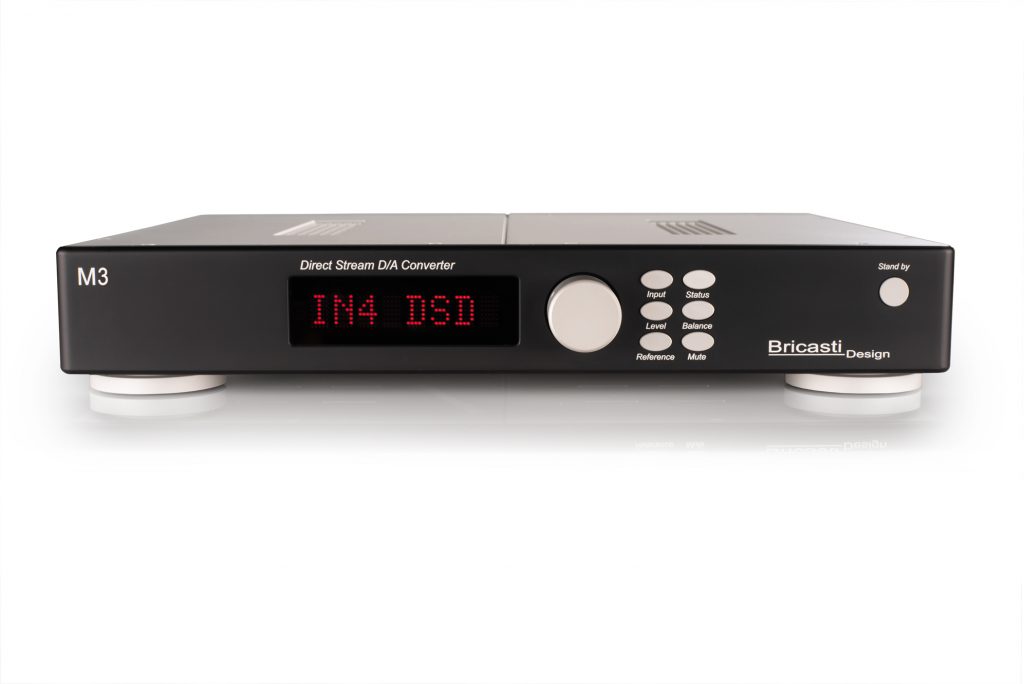Bricasti M3 - call for price
Bricast M3 DAC features two fully differential conversion channels, separate conversion for PCM and native DSD, and a balanced analog level control circuit, making the M3 suitable for all applications. Internally the M3 utilizes two independent linear power supplies for the analog and digital processing to ensure low noise and superior isolation.
The M3H adds a headphone amplifier option with balanced inputs for expanded utility in your audio system.
DESIGN HISTORY
The basis for M3 starts with the same proven design we made for the M1 D/A converter; a dual-mono signal path and a fully true balanced topology based on dual ADI 1955 converters, all linear power supplies, and a separate digital signal processing engine taken from the M1. Based on this proven design the next product we made was the M12, this is essentially the M1 with the addition of a discreet ladder analog level control which allowed us to develop our native DSD conversion. This then followed with the M21, a stand-alone DAC version of the M12 which included the NDSD conversion from the M12 also with an analog attenuation stage to manage the DSD.
Continuing the evolution of the M21 design work became the basis for the M3. A bit about our true DSD conversion In the M12 design, we had an idea to create a true DSD converter, in simple terms this is a very high-speed switch, up to 10GHz, followed by a low order analog filter. The problem presented in processing and converting DSD is that if one is to maintain true DSD then no digital signal processing can be done. Thereby most all converters convert DSD to multi-bit or PCM format, and once converted that allows for management of the playback for level matching, muting of transition noises are all simple and cost-effectively done in the digital domain, but the conversion is now PCM not a true DSD one. In the M12 we solved this by performing all these background tasks in the analog domain with our programmable level control. All the signal processing is elegantly done in the analog domain, transitions from PCM to DSD are silent and level matched. In the M12 this is a costly way to convert DSD, so when making the M3 we had to find a more cost-effective way to manage the analog signals and deliver NDSD. This technique was brought forward into the M21 and then the M3 for true DSD conversion.
POWERFUL ARCHITECTURE
The M3 utilizes two independent linear power supplies for the analog and digital processing to ensure low noise and superior isolation. A newly designed chassis made from robust CNC milled aluminum in sections ensures superior thermal characteristics, excellent vibrational damping, and shielding from RF.
RE-CREATING SOUND IS AN ART AND A SCIENCE
The M3’s digital design employs precision DDS clocking that lowers jitter to extremely low levels, ensuring a pure digital signal path without the use of sample rate converters, this combined with superior digital filter design, and Native DSD conversion yields a state of the art digital audio path. The M3’s high-speed low distortion analog path features a bypass-able preamp class analog level control allowing the M3 to be used to drive power amps directly, with no bit loss for optimal analog performance.
INTRODUCING THE M3H
The M3 was designed from the beginning to have a headphone buffer and driver amps to be added as options, so the chassis and dimensions remain the same on the M3H except for the front panel. There, you will find 2 connection points for an XLR and 1/4″ inputs. There is no change in the DAC components of the device, but there are additional driver cards inside the unit.
The M3 is a true balanced or differential DAC, and all its analog circuitry is fully balanced including the headphone driver amps. There are 4 amps in the M3H for headphone drive when using balanced out. It is unique in the market to have a full balanced path.
Since the M3 is analog, there is no change in the UI of the unit or controlling level. Bricasti will be adding the ability to select the different outputs: Headphone or main outputs on the device.
CONVERSION IN THE M3
The M3 features 2 digital audio conversion paths, 1 for PCM which utilizes a sigma-delta type as found in the M1, and one for DSD, a true one-bit modulator of our own design and unique to the industry. This DSD conversion is a true 1-bit analog converter followed by an analog post noise filter. The result is a pure DSD playback unlike any other converter in the market. Both converters create a true differential analog waveform from the digital data stream, and as in the M1, the M3 also employs a discrete current to voltage conversion stage to create the true balanced signal.
THE M3 ANALOG SECTION
As stated above, the M3 is a true balanced converter and the complete analog path and its attenuator are also true differentials. As in the M1, the M3’s unbalanced outputs are separately buffered allowing for use of both outputs at the same time to drive different amplifiers or preamps. A common use is to use one for driving a subwoofer and the other for a main speaker amp drive. The M3 has a robust linear analog power supply with voltage rails of +15V and -15V, therefore the M3 can be used to drive the power amps directly with no issue of available current. The M3 utilizes the same analog attenuator as the M21, this was chosen in the M21 and M3 for its small footprint and low power consumption. This attenuator has a dual function in the M3, one for managing the NDSD conversion path and the other is the ability to use the M3 as a preamp source, to direct drive the power amps or headphones The M3H – Delivering a True Balanced Source The M3 has the option for a balanced headphone driver, called the M3H. As stated above, as a converter the M3 is truly balanced and this follows through to all the analog stages of the M3, and this makes the M3 one of the only true balanced headphone sources. As with the main outputs, the headphone drivers are also separately buffered so that all outputs can be used at the same time with no consequences. Given the high voltage rails in the analog supply, the M3 is capable of driving most common headphones to acceptable listening levels with extremely low distortion.
The M3 delivers a true balanced source for all applications and the M3H is unique in the headphone market as one of the only true balanced sources to drive balanced headphones correctly providing the best conversion for both PCM and DSD sources and support of all input sources including network streaming.
DIGITAL INPUT SECTION
Depending on options, it provides 4 or 5 digital inputs selectable from the front panel. This section has its own linear power supply and is isolated from the analog section. Features and Analog Devices Sharc DSP that used to run:
- Front panel
- General DSP operations of M3
- Control and synchronize the DDS clocking
- Provide a selection of Bricasti’s oversampled anti-aliasing filters
ANALOG OUTPUT SECTION
- Both channels are powered by a separate linear power supply.
- Single multi-layer PCB for the analog conversion and analog output stages.
- Manages DSD audio path; maintains a true pure DSD converter.
- The M3 is a fully differential analog design with fast high slew rate fast settling analog operational amps used in all audio paths, for both balanced and unbalanced, each separately buffered and isolated.
TRIGGER
The rear panel has a stereo connection (TRS) for the trigger out of M3, used to place an external device like the Bricasti M15 power amp into standby. Trigger functions can be set in the status menu for trigger-in, trigger-out, or trigger-remote for exclusive operation and control from the M20 preamp.
OTHER FEATURES
- USB connection
- Optional Network Interface
- DSD playback
- Digital Oversampling Filters for PCM Conversion
- Optional M3 Remote
HANDCRAFTED IN THE USA
All of Bricasti’s products are crafted in the old world tradition, in a classic brick mill building in Massachusetts USA by a team of individuals dedicated to excellence.
.
PRESS AND REVIEWS
